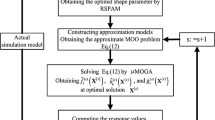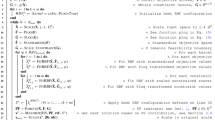Abstract
In many practical engineering design problems, the form of objective function is not given explicitly in terms of design variables. Given the value of design variables, under this circumstance, the value of objective function is obtained by some analysis such as structural analysis, fluidmechanic analysis, thermodynamic analysis, and so on. Usually, these analyses are considerably time consuming to obtain a value of objective function. In order to make the number of analyses as few as possible, we suggest a method by which optimization is performed in parallel with predicting the form of objective function. In this paper, radial basis function networks (RBFN) are employed in predicting the form of objective function, and genetic algorithms (GA) in searching the optimal value of the predicted objective function. The effectiveness of the suggested method will be shown through some numerical examples.
Access this chapter
Tax calculation will be finalised at checkout
Purchases are for personal use only
Preview
Unable to display preview. Download preview PDF.
Similar content being viewed by others
References
Arakawa, M. and Hagiwara, I. (1997), Nonlinear Integer, Discrete and Continuous Optimization Using Adaptive Range Genetic Algorithms, Proc. of ASME Design Technical Conferences (in CD-ROM)
Haykin, S. (1994), Neural Networks: A Comprehensive Foundation, Macmillan College Publishing Company
Hsu, Y.H., Sun, T.L. and Leu, L.H. (1995), A Two-stage Sequential Approximation Method for Nonlinear Discrete Variable Optimization, ASME Design Engineering Technical Conference, Boston, MA, 197–202
Kannan, B.K. and Kramer, S.N. (1994), An Augmented Lagrange Multiplier Based Method for Mixed Integer Discrete Continuous Optimization and Its Appliations to Mechanical Design, Transactions of ASME, J. of Mechanical Design, Vol. 116, 405–411
Myers, R.H. and Montgomery, D.C. (1995), Response Surface Methodology: Process and Product Optimization using Designed Experiments, Wiley
Nakayama, H., Yanagiuchi, S., Furukawa, K., Araki, Y., Suzuki, S. and Nakata, M. (1998), Additional Learning and Forgetting by RBF Networks and its Application to Design of Support Structures in Tunnel Construction Proc. International ICSC/IFAC Symposium on Neural Computation (NC’98), 544–550
Orr, M.J.L. (1996), Introduction to Radial Basis Function Networks, http://www.cns.ed.ac.uk/people/mark.html
Qian, Z., Yu, J. and Zhou, J. (1993), A Genetic Algorithm for Solving Mixed Discrete optimization Problems, DE-Vol. 65-1, Advances in Design Automation, Vol. 1, 499–503
Sandgren, E. (1990), Nonlinear Integer and Discrete Programming in Mechanical Engineering Systems, J. of Mechanical Design, Vol. 112, 223–229
Zhang, C. and Wang, H.P. (1993), Mixed-Discrete nonlinear Optimization with Simulated Annealing, Engineering Optimization, Vol. 21, 277–291
Author information
Authors and Affiliations
Editor information
Editors and Affiliations
Rights and permissions
Copyright information
© 2001 Springer-Verlag Berlin Heidelberg
About this paper
Cite this paper
Nakayama, H., Arakawa, M., Sasaki, R. (2001). A Computational Intelligence Approach to Optimization with Unknown Objective Functions. In: Dorffner, G., Bischof, H., Hornik, K. (eds) Artificial Neural Networks — ICANN 2001. ICANN 2001. Lecture Notes in Computer Science, vol 2130. Springer, Berlin, Heidelberg. https://doi.org/10.1007/3-540-44668-0_11
Download citation
DOI: https://doi.org/10.1007/3-540-44668-0_11
Published:
Publisher Name: Springer, Berlin, Heidelberg
Print ISBN: 978-3-540-42486-4
Online ISBN: 978-3-540-44668-2
eBook Packages: Springer Book Archive




